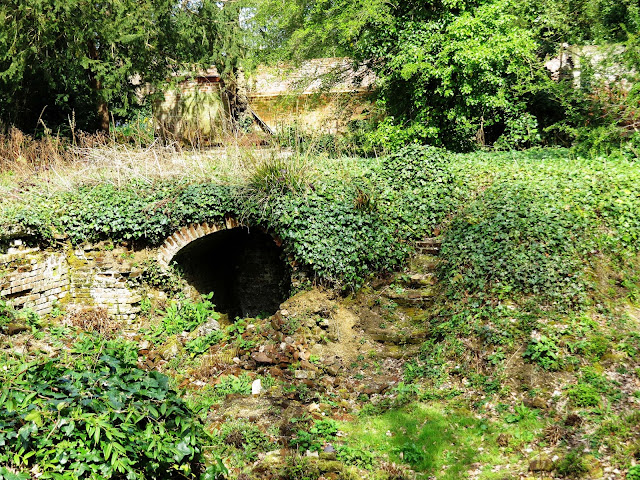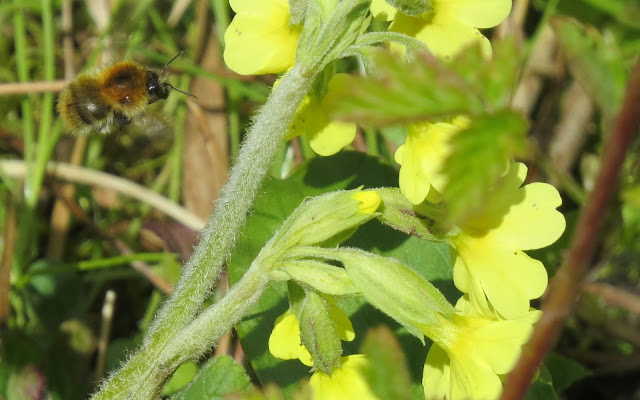I don't suppose Ellen Willmott, the famous horticulturist who lived in Warley Place in Essex from 1875 until her death in 1934, would be less than horrified at the appearance of her former home. The large country house that she knew is in ruins and only the shell of the conservatory still stands. Ivy climbs over the rubble of her home and wild flowers push through the bricks. And her greenhouses and cold frames, the centre of her gardening activities, are now down to their foundations - crumbling outlines of what they once were.

I thought about Miss Willmott coming forward in time when I visited Warley Place last week and imagined the sight of her wandering around today. I think she would be horrified - but perhaps only at first, because all the buildings have gone and her neat gardens are overrun (apparently she would sack a gardener if she spotted a weed.) But I hope after her first inspection she'd realise that so much of what she created still flourished - like her acres of daffodils - and that her old estate is managed well by volunteers who have simply let it become a place of wild, natural beauty. Warley Place is now a nature reserve, owned by the Essex Wildlife Trust.
 |
| Brimstone on Bluebell |
Spring is a great time to visit Warley Place. In fact, it's really worth visiting several times over the season, first of all to see the drifts of snowdrops and then the stunning carpets of daffodils. When I visited, these were starting to fade (which looked sort of appropriate here where there is a sense of gentle decay). But the daffs are being replaced by a fresh blue, as the bluebells, forget-me-nots and pulmonaria are now in flower. Along the paths, the wild garlic is coming out with its pungent smell. I also think it'll be worth visiting again in a few weeks because there are masses of self-sown foxgloves. I saw the clumps of leaves all around the ruins and I think these will look glorious in early summer.

Ellen Willmott brought in flowers from abroad and is thought to have cultivated over 100,000 different species of trees, plants and shrubs. More than 60 plants have been named after her and Warley Place, including Eryngium giganteum (Miss Willmott's Ghost) - a large sea-holly. She received many accolades for her plants and was one of the first recipients of the RHS Victoria Medal of Honour in 1897.
 |
| Ellen and her sister Rose taking tea under the Walnut Tree c1900 |
There are some interesting trees here too such as 'Umbellularia californica' (known as the headache tree, because crushing the leaves creates a headache) and the turkey oak, which has a parasitic growth on its branch known as a witch's broom. Probably the most impressive trees of all are the old, gnarled sweet chestnuts. In 1649 John Evelyn the Diarist purchased the manor of Warley Magna - of which Warley Place is a part. The story goes that he was thought to have planted these sweet chestnuts, although it seems that only one of the present trees actually dates back that far.
The sweet chestnuts are lovely trees and while I was looking at them I noticed that the birds love them, too. I had to smile at this blue tit, which was completely ignoring the purpose built nest box for the hole around the corner in the trunk.
Ellen Willmott created lots of interesting features at Warley Place, such as an Alpine gorge (with stone brought down from Yorkshire)...
There are three ha-has here - deep banks and ditches established to keep the livestock away from the gardens (apparently the name ha-ha comes from the reaction of someone who suddenly stumbles across the vertical drop - although I can't imagine you'd laugh very much if you tripped into the ditch...)
Miss Willmott inherited a walled garden at Warley Place (which was probably established in the early 1600s) but much of what is here today is the result of her planting...
There is a history here, of course, that predates Ellen Willmott and John Evelyn. The old carriage drive to the house was once part of a main road and, in the Middle Ages, this road was once part of the pilgrimage route from Canterbury to Walsingham.
The Warley Place estate was part of land owned by Barking Abbey, which was later dissolved by Henry VIII. The king then gave this land in Warley to his naval minister, William Gonson.
There are North and South ponds here. This pond, the South Pond, once supplied water to the local village...
At this time of year, it's full of marsh marigolds. A bird hide has also been set up on one side.
Ellen Willmott was well known in her time; she received visits from royalty at Warley Place. But she became increasingly eccentric towards the end of her life; she apparently booby trapped her estate for protection and wandered around with a revolver in her handbag. She also spent extravagantly throughout her life on her search for plants and seeds and eventually lost her money, so that many of her possessions had to be sold. This all seems very sad for a woman who had such a vast knowledge, expertise and talent in horticulture.
 |
| Purple toothwort - a parasitic plant dependent on other plants to survive. |
Still, Warley Place has been protected (although I think it's strange that it hasn't been protected by the RHS but by Essex Wildlife Trust). Wandering around, I saw robins, wrens, blue tits, great tits and other birds starting to nest there last week and the reserve was full of bird song. But even if Warley Place as a wild and natural site wouldn't have appealed to Ellen Willmott, I have to admit that, if I were her, I'd be delighted that my former home was now a protected nature reserve, cared for by volunteers, with so much wildlife making a home there.

























